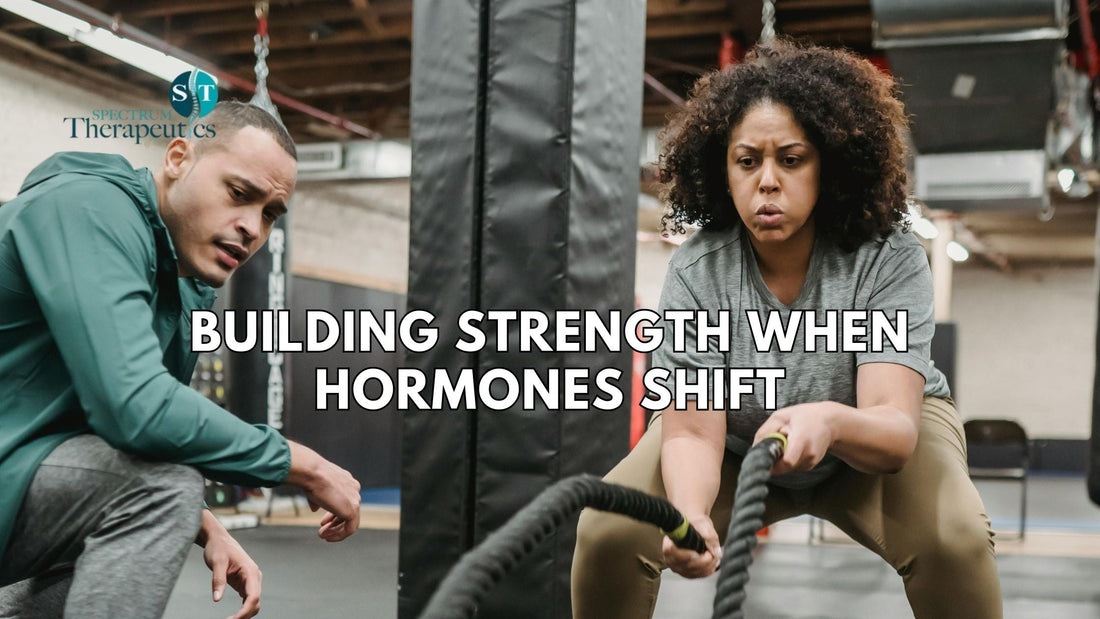
Building Strength as Hormones Change: What I've Learned in 15 Years of Practice
Dr. Rob Letizia PT, DPTShare
Disclaimer: This content is for educational purposes only and does not constitute personalized medical advice. Always consult with your healthcare providers before making changes to your exercise routine, supplements, or medical treatments.
The Reality Check That Changed My Practice
About five years ago, I had a patient, let's call her Sarah, who came to me after breaking her wrist from what should have been a minor fall. She was 48, considered herself active, but when we did her initial assessment, I was genuinely surprised. Her grip strength was significantly lower than I'd expect for someone her age, and her bone density scan showed early signs of concern.
That appointment made me realize something: I needed to completely rethink how I approach women's health in my practice.
What's Really Happening in Your 30s and 40s
Here's something that often surprises my patients: hormonal changes don't just happen overnight at menopause. They're a gradual process that typically begins in your mid-30s. I've watched this play out with hundreds of patients over the years, and the pattern is remarkably consistent.
Research shows that estrogen levels begin declining years before menopause actually occurs. While the exact percentages vary between studies and individuals, what's clear is that this decline affects much more than reproduction. Estrogen plays crucial roles in maintaining bone density, supporting muscle protein synthesis, and even influencing how your body responds to exercise.
When estrogen levels drop, many of the physical tasks that used to feel automatic become more challenging. Recovery takes longer. Muscle mass becomes harder to maintain. Bones gradually lose density.
This isn't about scaring anyone, it's about understanding what's happening so we can work with these changes, not against them.
Why I Stopped Being a "Variety is Key" Trainer
Early in my career, I was all about mixing things up. A little cardio here, some yoga there, maybe some light weights thrown in. I thought variety was the secret sauce.
Then I started seeing a pattern in my practice: women who had been religiously doing step aerobics, spinning, and group fitness classes for decades were still ending up in my clinic with stress fractures, osteoporosis, and significant muscle loss.
Don't get me wrong, I'm absolutely not anti-cardio. Cardiovascular fitness is important for heart health, mood, and overall wellbeing. But if cardio is your only form of exercise, you're missing a critical piece of the puzzle.
Research consistently shows that muscle mass is one of the strongest predictors of healthy aging and independence. More important than BMI, more important than how fast you can run a 5K, more important than most of the metrics we typically focus on.
The Strength Training Reality Check
Let me be direct about something: if you're not doing regular resistance training, you're fighting an uphill battle against the natural changes your body is going through.
I've treated 45-year-old women who struggle to get out of a low chair without using their hands. I've worked with 52-year-olds who threw out their backs lifting a bag of groceries from their car trunk. This isn't inevitable aging, it's preventable muscle loss.
Based on current exercise guidelines from organizations like the American College of Sports Medicine, the minimum effective dose for strength training is two sessions per week, focusing on compound movements that work multiple muscle groups. Think squats, deadlifts, rows, and presses, exercises that mimic real-life movement patterns.
And let me address the elephant in the room: No, you will not get "bulky" from strength training. In 15 years of practice, I have never, not once, seen a woman accidentally build too much muscle. Building significant muscle mass requires very specific training protocols, nutrition timing, and often genetic predisposition that most people simply don't have.
What you will get is stronger bones, better functional movement, improved metabolism, and the confidence that comes with knowing your body can handle whatever life throws at it.
Navigating the Hormone Conversation
As a physical therapist, I stay in my lane when it comes to hormone replacement therapy, that's a decision that belongs between you and your physician. But I do think it's important to address the fear and confusion I see in my practice.
Many of my patients are afraid to even bring up HRT with their doctors because of concerns stemming from older research. What I can tell you from a movement and musculoskeletal perspective is this: some of my patients who work with knowledgeable physicians to address hormonal changes see improvements in their energy, recovery, and ability to build and maintain muscle mass.
If you're experiencing symptoms that are affecting your quality of life or your ability to stay active, it's worth having an informed conversation with a healthcare provider who stays current with women's health research. Don't let fear of outdated information prevent you from exploring all your options.
Nutrition: The Foundation That Actually Matters
Over the years, I've watched patients completely transform their energy levels and recovery by addressing just a few key nutritional areas:
Protein: This is the big one. Most women I work with eat roughly half of what they need to support muscle maintenance and recovery. If you're strength training regularly, research suggests aiming for approximately 0.8-1 gram per pound of body weight. That might sound like a lot if you're used to eating much less, but protein is literally the building blocks your muscles need to adapt and recover.
Key Micronutrients: Many of my patients benefit from addressing common deficiencies, particularly:
- Magnesium (involved in muscle function and sleep quality)
- Omega-3 fatty acids (for their anti-inflammatory properties)
- Adequate fiber (supporting gut health and overall inflammation levels)
Important Note: Before starting any new supplements, please consult with your healthcare provider. Individual needs vary greatly based on your health history, current medications, and existing conditions. What works for one person may not be appropriate for another.
What I've Observed at Home
My wife is 46 now. She's always been active, runs regularly, practices yoga, eats thoughtfully. But over the past couple of years, she started noticing changes that sounded familiar from my practice. Recovery took longer after workouts. Sleep felt less restorative. Energy would dip significantly in the afternoons.
About six months ago, she decided to add strength training to her routine twice a week. Not the light dumbbell work she'd done occasionally, but real progressive resistance training. Squats with a barbell. Deadlifts. Rowing variations.
The changes were noticeable within a few months. Better sleep. More consistent energy. And something harder to quantify but equally important, a sense of physical confidence she hadn't realized she'd been losing.
I share this not as a case study or to sell anyone on a particular approach, but because it illustrates something I see regularly in my practice: when we give our bodies the stimulus they need to adapt, they respond remarkably well, even with hormonal changes happening in the background.
Playing the Long Game
Here's what 15 years of treating women through midlife transitions has taught me: the choices you make in your 30s and 40s have a profound impact on your quality of life in your 70s and 80s.
I have patients in their mid-70s who hike regularly, travel independently, and maintain active social lives because they started prioritizing strength and bone health in their 50s. I also work with patients in their early 60s who struggle with basic activities of daily living because they thought staying generally "busy" was enough.
The difference usually isn't genetics or luck. It's habits, implemented consistently over time.
Moving Forward: Three Non-Negotiables
If you take nothing else from this article, please consider these three points:
-
Start strength training before you feel like you need it. Don't wait until you feel weak or notice significant changes. The best time to build strength reserves is when you still have them.
-
Have honest conversations with knowledgeable healthcare providers. Whether it's about hormones, nutrition, or exercise modifications, make sure you're working with professionals who stay current with research and understand the unique challenges women face during these transitions.
-
Prioritize protein and recovery. Your body needs different support now than it did in your twenties. That's not a failing, it's just biology.
This isn't about becoming a fitness influencer or competing in powerlifting meets. It's about maintaining your independence, your confidence, and your health span, not just your lifespan.
The goal is simple: when you're 75, you want your body to be an asset, not a limitation.
Dr. Rob Letizia is a Doctor of Physical Therapy with 15 years of experience treating orthopedic and women's health conditions. His practice focuses on helping women navigate the physical changes of midlife through evidence-based strength training and lifestyle interventions. This article is for educational purposes only and should not replace personalized medical advice from your healthcare providers.



